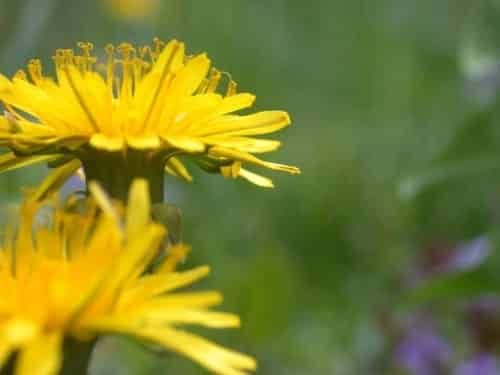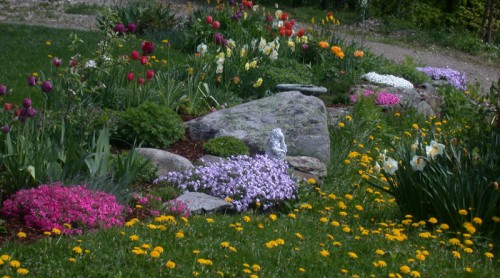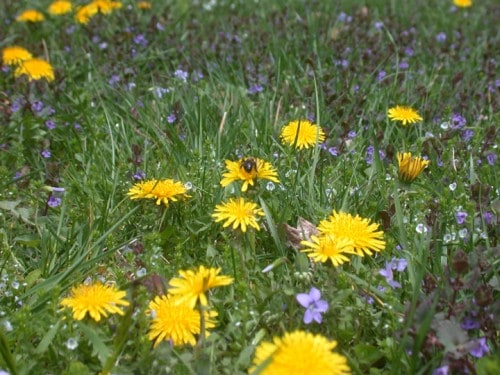By Erica Bowman, JMMDS
Perfectly manicured mono-cultured lawns are the aspiration of many, but I prefer mine to be au naturel. I like the lawn to be “multicultural,” and the longer I can keep my husband from using the lawnmower the better. By May, if I am lucky, my home turf reads more like a vivid collection of low-growing wildflowers than a golfing green, and my winter-weary eyes can’t help but call it a garden.

Photo: Erica Bowman.
Dandelions (Taraxacum officionale), perhaps the greatest pariahs of the plant kingdom, are often banned from the landscape. Luckily, things are a bit looser around here. These yellow-headed dandies are sure harbingers of summer in Vermont, dappling almost every field with bright dots of sunshine. They bring contrast to the brilliant green of the new lawn’s blades and complement the bright colors in the springtime perennial bed. It’s important, however, to mow the lawn before the seeds take flight in order to keep them from entering the perennial bed itself. That is where even I draw the line.

Try seeing flowering dandelions as a beautiful complement to perennial beds—just make sure you mow them before they go to seed! Photo: Erica Bowman.
Perhaps one of the most tempting expanses on the lawn is the colony of pussy toes (Antennaria neglecta). Like a field of fuzzy pillows, this patch of lawn makes me want to snuggle down and take a nap. The bluets (Hedyotis caerulea) form similar colonies in lush proportions. Luxurious cushions of blue, these guys are just as eye-catching as the creeping phlox of the perennial bed. Other plants that are subtle when solo can make a large splash in groupings. Ground ivy (Glechoma hederacae) may have an ugly-sounding botanical name, but its gorgeous purple tubular flowers really make an impact en masse, not unlike its later-blooming friend, Ajuga reptans.
L: Pussy toes (Antennaria neglecta). Photo: Erica Bowman. C: Bluets (Hedyotis caerulea, formerly known as Houstonia caerulea). Photo:Duke.edu. R: Ground ivy (Glechoma hederacae). Photo: Erica Bowman.
There are some perennial bed escapees that I let flourish upon the spring lawn. Biennial forget-me-nots (Myosotis sylvatica) will be sure to return year after year to gardens that allow reseeding. Pinks (Dianthus armeria or Dianthus deltoides) can be dug up and returned to the garden to escape the inevitable mower. Wild strawberry plants (Fragaria virginiana), which had no place in the perennial bed to begin with, are welcome to return to their rightful place in the lawn.

Some plants from the perennial border spread freely into the adjoining lawn. L: Forget-me-nots (Myosotis sylvatica). C: The attractive foliage of pinks (Dianthus armeria or Dianthus deltoides). R: Wild strawberry (Fragaria virginiana). Photos: Erica Bowman.
The violets of my lawn’s garden come in all colors, sizes, and species. Distinguishing between the species can be a difficult task since even the common blue violet (Viola sororia) comes in varying shades of blue and white. Without too much study, I can expect to find sweet white violet (Viola blanda), Canada violet (Viola canadensis), and, earlier in the season, the round-leaf yellow violet (Viola rotundifolia). Not a violet but a Viola all the same, I also have plenty of Johnny-jump-up (Viola tricolor) volunteers, but they seem to prefer the cultivated spaces, like my waiting vegetable garden. All of these Violas, by the way, find their way onto my springtime salad plate along with tasty weeds like wood sorrel, winter cress, and dandelion greens.

Assorted Violas: common blue and white violets, purple-and-gold Johnny-jump-ups. Photos: Erica Bowman.
In addition to beauty and biodiversity, a multi-cultural lawn offers another advantage: it eliminates the need for herbicides which many people rely on to maintain a monoculture of grass in their lawns. Leave out the chemicals—and see how many beneficial pollinators are drawn to your garden.

A happy bee in a chemical-free lawn. Photo: Erica Bowman.







Two great posts in a row. So many should read both. I like your philosophy on lawns. I too am chemical free, but am surrounded by those using all kinds of spray pesticides. Very few butterflies last year and I really missed them. Loads of bees in my yard though.
Our lawn in northern Virginia has many of the same “multicultural” visitors, although I fear the invasive Japanese stiltgrass is beginning to crowd some out. How I wish I could confine the wild strawberries to the lawn and deter them from recolonizing the perennial bed.
In case you didn’t know, dandelion is the flower most associated with St. Brighid.
My lawn has been taken over by ground ivy (creeping charlie, I thought it was called)–I was amused to read you actually enjoy the purple flowers. I have been dismayed by its invasiveness and yet refuse to use an herbicide so live with it. Thanks for making me not dislike it quite so much. Lynn cavo
One day i took the spade to my front lawn to begin a large perennial garden. I have never regretted it. I only wish that i had more lawn to dig up. Here’s to spring and dandelions. Good Job !
Thank you Erica! What a lovely post! I also adore the flowers that pop up in my spring lawn, especially violets and dandelions, which are so wonderfully celebrated by Vachel Lindsay’s poem, “The Dandelion”:
Oh Dandelion, rich and haughty,
King of village flowers,
Each day is coronation time.
You have no humble hours.
For you and Julie and all my friends there at JMMDS, and for any blog followers who might be interested, here’s a link to my setting of the poem (for Celtic harp and voice): http://www.reverbnation.com/play_now/7792629
Dear Carol,
I played your interpretation of the poem and was so moved by the beauty of its tone and melody. It rang of spring to me. I also was reminded of my favorite Joni Mitchell in the vast range of notes. What is even more special is the full-circle of artistic sharing that just transpired. Thank you for giving us such a wonderful gift.
Erica
To mow or not to mow? Only with her permission.
Erica, you’re too kind, and I’m immensely flattered that the song reminds you of the great Joni!